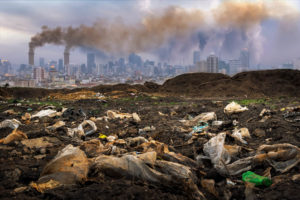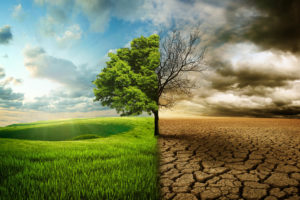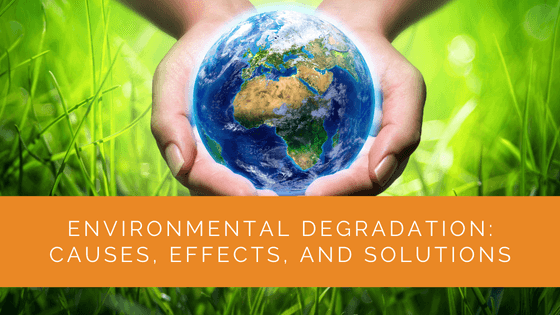Be it the television or the internet, news of natural disasters and the impact of pollution have become all too common. This disintegration of our planet and its resources is gradually deteriorating modern life.
The effects of environmental degradation span way across several human facets. On the one hand, these issues lead to biodiversity loss, while on the other, people face the spread of contagious diseases.
As a modern global citizen, it is essential to understand the sources and impact of environmental degradation on our natural resources. Consequently, we can modify our research and implement new solutions for the sustainability of our planet.
This article covers all the interrelated aspects of environmental degradation.
Contents
- 1 Key Takeaways
- 2 What is Environmental Degradation?
- 3 The Major Causes of Environmental Degradation
- 4 The Effects of Environmental Degradation
- 5 Practical Solutions to Environmental Degradation
- 6 Environmental Degradation in a Nutshell
- 7 Expert Insights From Our Solar Panel Installers About Environmental Degradation
- 8 Wrapping Up
Key Takeaways
- Environmental degradation is the deterioration of our ecology due to negative impacts on natural habitats and resources, which can lead to biodiversity loss, spread of diseases, and other detrimental effects.
- Environmental degradation falls into three main categories: water degradation (caused by industrial waste, sewage, and more), land degradation (resulting from factors like deforestation and illegal waste dumping), and atmospheric degradation (due to air pollution and emissions).
- Major causes of environmental degradation include overpopulation, modern consumption behavior, illegal waste dumping, deforestation, and natural calamities. It significantly affects human health, livelihoods, tourism, climate, and natural resource exhaustion. Practical solutions include government regulations, reducing consumption levels, stopping deforestation, reusing and recycling, and reducing the use of fossil fuels.
What is Environmental Degradation?
Simply put, environmental degradation is the deterioration of our ecology due to the negative impact on natural habitats and resources.
This degradation is a cumulative outcome of one or more of the following facets:
- Water pollution
- Depletion of soil
- Polluted air
- Impact on animals and plant life
Environmental degradation has three main subcategories — water, land, and atmospheric.
Water Degradation
This type of pollution occurs mainly due to the release of harmful materials into potable water bodies. With less than one percent readily accessible freshwater, we cannot afford to deteriorate our water resources further.
Several human activities lead to such a negative impact on our water resources:
- Industrial waste disposal
- Washing of clothes and automobiles
- Improper disposal of sewage water
- Chemical pesticide contamination
- Oil spillage
- Increase in ocean acidity
Hence, there is a direct impact on animal and plant life related to various water resources. Without stringent norms across the globe, water scarcity can become an evident problem shortly.
Land Degradation
This degradation category occurs mainly when the soil undergoes contamination for various reasons. As a result, the land becomes inapt for dependent organisms.
Factors like plastic pollution can also lead to the degradation of land. Here are other causes that lead to land degradation:
- Disposal of non-degradable waste
- Dumping of radioactive material
- Throwing large chunks of biodegradable waste
- Deep mining
- Groundwater over-drafting
- Deforestation
Land degradation leads to a loss in the quality of crops that grow in affected areas. In addition, soil loses fertility, leading to food scarcity, loss of income, and other relevant negative impacts.
Atmospheric Degradation
This environmental degradation is a result of air pollution. Notably, atmospheric degradation is a direct contributor to issues like global warming.
Here are some of the crucial causes for this type of degradation:
- Industrial and vehicular emissions
- Burning of fossil fuels
- Emission of harmful CFCs
- Release of particulate matter
- Reduction of vegetation across the planet
- Volcanic eruptions
- Wildfires
Atmospheric degradation has a noticeable effect on human, plant, and animal health. Gases like carbon dioxide contribute to the rise in global temperature. Also, people face breathing difficulties due to contaminated air.

The Major Causes of Environmental Degradation
Listing the sources of environmental degradation can become lengthy. So, this section focuses on the major causes that lead to trending issues like water shortages or soil erosion.
1. Overpopulation
Decreased death rates and advancement in modern science are the major contributors to population growth. We use nearly 1.78 Earth to provide ecological resources for our requirements.
To meet this increasing demand, we must exploit the existing resources that lead to environmental degradation.
Hence, the increasing number of vehicles and the need for material goods and essential supplies are innate to the rising population. All these factors exert an additional burden on our natural resources and environment.
2. Modern Consumption Behavior
Be it plastic, electronic gadgets, or soft drinks, people choose products that impact the planet’s sustainability.
As a result, companies adopt technologies for mass production, neglecting their hazardous effect on the ecology. For instance, the high demand for minerals requires heavy mining activities. These tasks lead to land degradation and noise pollution.
Also, factories emit greenhouse gases that end up damaging the ozone layer. So, to create a positive impact, people need to change their consumer behavior and adapt to sustainable products like eco-friendly textiles.
3. Illegal Waste Dumping
Illegal waste dumping is a common activity from industries to individuals like farmers. However, the scale of illegal waste disposal from some factories is colossal.
Dumping contaminants in lakes, lands, rivers, etc., pollutes the natural habitat. Also, accidents like oil spills harm aquatic life to a considerable extent. Disposing of trash in forests also contributes to groundwater contamination.
So, illegal waste dumping has become one of the major concerns for environmental degradation. Strict norms and monitoring are crucial to prevent such harmful activities.
4. Deforestation
Forests are natural regions with an all-important vegetation belt. In addition, jungles are home to various organisms, animals, and plant species.
These areas contain trees that produce oxygen, thereby countering the negative impact of greenhouse gases. However, cutting down forest trees hampers this natural phenomenon. Here are the main reasons for deforestation:
- Agricultural expansion
- Extraction of wood
- Expansion of roads and infrastructure
Irrespective of the intention, deforestation leads to environmental degradation in various facets. It leads to atmospheric and land deterioration. In addition, it is a major cause of the loss of biodiversity on the planet.
5. Natural Calamities
Humans aren’t solely responsible for environmental degradation. Here are some natural disasters that can pollute and disrupt the ecology:
- Tidal waves
- Earthquakes
- Volcanic eruptions
- Avalanches
- Landslides
These activities can degrade the normal functioning of organisms at different locations. Hence, residents can face various types of pollution and their ill impact.
In some cases, the physical demolition of huge buildings can cause land and soil degradation. The improper disposal of debris can also impact water bodies and fertile lands. So, combining natural and man-made disasters is another major cause of ecological degradation.

The Effects of Environmental Degradation
Environmental degradation impacts all living species, from animals to humans and plants to other organisms. This section explains some of the major consequences of this phenomenon.
1. Human Health
Public health issues due to environmental degradation are well-known problems. For instance, air pollution causes the following diseases:
- Pneumonia
- Respiratory tract infection
- Asthma
On the other hand, land degradation leads to deterioration in soil quality. The crops that grow on such lands pose health hazards to the general public—polluted water causes diseases in the stomach.
The eventual water scarcity will lead to famines and further impact human health. Also, activities like mining cause noise pollution, leading to other medical issues.
2. Loss of Livelihood
Global warming is causing the melting of the earth’s glaciers and a rise in sea levels. As a result, people living in coastal areas need to migrate to regions at higher altitudes.
This migration is responsible for the loss of livelihood among several people. Environmental degradation has a direct impact on agricultural activities. Hence, this phenomenon can negatively impact a massive sector of employment.
A lack of basic needs like food and shelter will lead to a rise in poverty, especially in poor and developing nations.
3. Impact on Tourism
Biodiversity and nature are vital aspects of the tourism industry. People from developed nations travel abroad to witness magnificent beaches, forests, and other natural marvels.
Environmental degradation, however, proves hazardous to such natural resources. Production of waste, loss of biodiversity, and pollution hamper the beauty of attractive tourist destinations.
Hence, countries dependent on tourism will face a significant financial burden due to decreased income. Also, tourists will have limited spots for a nice and refreshing vacation.
4. Climatic Changes
The depletion of the ozone layer and alteration in the water cycle contribute to the changes in the earth’s natural processes.
Here are some of the popular abnormalities that result from a deterioration of the environment:
- Untimely rains
- Flashy floods
- Extreme heat waves
- Abnormal snowfall
- Abrupt weather changes
With each year, these atmospheric changes can become more lethal. Consequently, such abnormal changes will have an economic impact and spread of diseases.
5. Gradual Exhaustion of Natural Resources
Environmental degradation leads to the overuse of existing natural resources. The higher demand than supply causes a scarcity of resources.
In comparison, replacements for conventional sources have practical challenges. These issues are related to mass implementation, costs, and effectiveness. Hence, further deterioration of ecology eventually leads to a decrease in natural resources.
This exhaustion will increase the costs of essential commodities. So, emerging markets and developing countries will become incapable of sustaining themselves shortly.

Practical Solutions to Environmental Degradation
Controlling environmental degradation is a long process. However, certain steps can initiate the repair work. Here are some effective solutions to counter and reduce the negative impact of ecological disturbances.
1. Implementation of Strict Government Regulations
The intervention of local and national governments is the key to tackling eco-degradation. Governments should include individuals and large corporations in a strict penalty bracket.
These penalties should cover the following activities:
- Deforestation
- Illegal waste disposal
- Excessive mining
- Dumping of chemicals
- Improper recycling of products
Notably, such measures can help counter problems like plastic pollution and other ecological disruptions.
2. Reduction in Consumption Levels
For a sustainable planet, taking care of its natural habitat is crucial. An effective strategy for this purpose is to control the consumption of non-renewable sources.
Instead, using eco-friendly products will help reduce the demand for traditional items. As a result, there will be less exploitation of existing resources. Also, less consumption of material goods will lead to a reduction in waste.
This change in consumer lifestyle will help tackle the problem of environmental degradation. For this purpose, educating modern customers about sustainable products will prove instrumental.
3. Planting Trees and Stopping Deforestation
Protecting our forests can positively impact reversing the damage to the environment. For this purpose, there should be a collective effort that focuses on the following aspects:
- Declaring forest zones
- Imposing heavy fines and penalties on trespassers
- Planting more trees
- Creating safe zones for animal and plant life
This solution can protect the remaining species and help counter the ill effects of global warming. Also, this remedy aligns with the natural methodology of countering the hazardous impact on the atmosphere.
4. Reuse and Recycle
Many materials support easy recycling through various methods. Governments and brands should promote the use of such materials.
Common examples of these materials are as follows:
- Bamboo
- Cork
- Precast concrete
- Wool
Recycling reduces the amount of waste that contributes to landfills. Also, companies do not need to collect new raw materials, preventing pollution. Such benefits elevate the sustainability of the planet.
Hence, reusing products and practicing efficient recycling can help curb the negative effects of environmental degradation.
5. Reducing Use of Fossil Fuels
Simple tips like using public transport, solar energy, and switching appliances OFF can control the utilization of fossil fuels.
In addition, technological advancements in the automobile sector can lead to the manufacturing of fuel-efficient cars. This way, people will consume fuel in low quantities. Consequently, this solution will reduce the effect of global warming.
Switching to renewable energy sources can also prove effective for this solution. Hence, wind, geothermal, hydropower, and bioenergy are potential alternatives.

Environmental Degradation in a Nutshell
Here’s the summary of the main causes, effects, and solutions to the ever-growing issue of ecological deterioration.
| Causes | Effects | Solutions |
| Overpopulation | Human health impact | Implementation of strict government regulations |
| Excessive consumption | Loss of livelihood | Reduction in consumption levels |
| Waste dumping | Impact on tourism | Stopping deforestation |
| Deforestation | Climatic changes | Reuse and recycle |
| Natural calamities | Exhaustion of natural resources | Reducing the use of fossil fuels |
Apart from these major aspects, rainwater harvesting, reducing the use of CFCs, and treatment of industrial effluents are other effective solutions.
There should be a collective effort across the globe to solve the issue of environmental degradation. As a result, it can be possible to control various forms of ecological disturbances.
Expert Insights From Our Solar Panel Installers About Environmental Degradation
The impact of overpopulation on environmental degradation cannot be overstated. Increased demand for resources leads to deforestation, overexploitation of water resources, and a rise in pollution levels, all contributing to the deterioration of our natural environment.
Environmental Scientist
Modern consumption behavior is a significant driver of environmental degradation. The reliance on single-use plastics, electronic waste, and non-renewable resources exacerbates pollution and resource depletion. Shifting towards sustainable consumption practices is crucial for mitigating these impacts.
Sustainable Practices Advocate
Illegal waste dumping is a pervasive issue that severely impacts both land and water ecosystems. Strict regulations and enforcement, combined with public awareness and education, are essential to combat this environmental threat effectively.
Waste Management Expert
Wrapping Up
Awareness of environmental degradation’s causes, solutions, and effects is vital today. This way, communities, organizations, and governments can take appropriate measures.
The planet’s sustainability depends on the effective implementation of practical solutions. Hence, the onus is on individuals and companies to minimize harmful environmental activities. Controlling the types of eco-degradation will become successful if the solutions find global applications.
Spreading general awareness at the school level can be a good start. In addition, governments should come together and plan practical rules to protect the environment. Such a measure can have a long-term impact on nature and atmospheric conservation.
About the Author
Solar Panels Network USA stands at the forefront of solar energy solutions, driven by a team of seasoned solar engineers and energy consultants. With over decades of experience in delivering high-quality solar installations and maintenance, we are committed to promoting sustainable energy through customer-centric, tailored solutions. Our articles reflect this commitment, crafted collaboratively by experts to provide accurate, up-to-date insights into solar technology, ensuring our readers are well-informed and empowered in their solar energy decisions.

